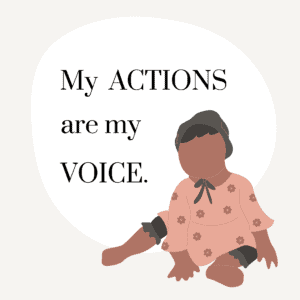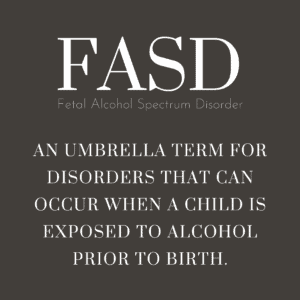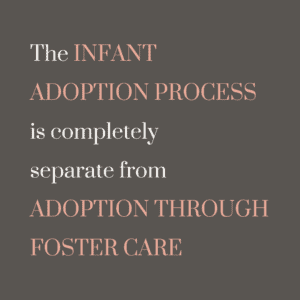Some of the youngest children in foster care have only been outside their mother’s womb for a few days. It is estimated that approximately 50,000 infants enter the foster care system every year.
How do babies end up in foster care?
Do infants experience trauma?
Does choosing life mean the baby enters foster care?
What is it really like being a foster parent to an infant?
These are all common questions regarding the youngest children in the foster care system. Here are six myths about babies in foster care and six explanations to set the record straight.
Any child who is in the foster care system has experienced a level of trauma, no matter their age. Caregivers must be trauma informed, nurturing, and flexible when welcoming a child into their home.
It is a common misconception that because a child is younger, they are more resilient to trauma. Children are not invincible to trauma at a young age. Additionally, stress responses will often look different for infants than they do for older children.

Infants who are in foster care are often still carrying the effects of a toxic stress response. Toxic stress is when the human body is unable to properly recover from a prolonged reaction to immense stress. This can have a lasting effect on learning, behavior, and overall health. Some causes of toxic stress include abuse, neglect, and household dysfunction.
At young ages, a child’s actions are a child’s voice. Loud, disruptive, and restless cries may really be a traumatized child’s responses to extreme stress. Understanding trauma is crucial when fostering children of any age, but especially infants. This means becoming educated on what trauma responses look like and how to care for a child that has experienced trauma.
Although many babies enter the foster care system, it is common for them to be quickly reunified with their families. The average age of a child in foster care is eight to nine years old. There is a far greater need for parents willing to foster children of an older age.
While babies are commonly the most desired age to foster, there are more waiting children of older ages. These children are also in need of a loving family to welcome them in.
Like any child who is in foster care, babies are impacted by the life experiences that have brought them there.
No child in foster care will be free of trauma. Additionally, children in foster care may be more likely to be affected by conditions such as Fetal Alcohol Spectrum Disorder or Reactive Attachment Disorder. For example, on average, a child with FASD is 17 to 19 times more likely to be in the child welfare system than someone without FASD.
Caring for babies in foster care may look different than caring for other infants. It is important to seek out resources and education on how to provide the safest environment for children in foster care. Patience, flexibility, and a willingness to learn are all essential.

Fetal Alcohol Spectrum Disorder (FASD) is an umbrella term for disorders that can occur when a child is exposed to alcohol prior to birth. FASD can have a variety of symptoms.
In infants, some common symptoms of FASD are low birth weight, high-pitched crying, seizures, or hyperactivity. In older children, these symptoms may appear as impulsivity, learning delays, lack of focus, growth deficits, and poor social skills.
These symptoms and disabilities may not be easily treated. Caregivers often have to adopt a specific style of parenting for children with FASD.
FASD may also occur in infants born to mothers who have an unexpected pregnancy and decide to make an adoption plan. For this reason, both foster and adoptive parents should be familiar with the conditions that may affect children in their home.
Reactive Attachment Disorder (RAD) is a rare but serious condition in which children are unable to form a healthy attachment to their parents or caregivers. RAD may occur in infants who enter foster care if the child has experienced neglect or abuse. When a child’s most basic needs go unmet, they struggle to form healthy attachments.
Symptoms of RAD in infants can be listlessness, not reaching for caregivers, or not smiling. One of the primary treatments for RAD is a stable, loving environment in which a caregiver meets a child’s needs. With these efforts, a child may develop a healthy relationship with caregivers.
Many people desire to foster or adopt infants. However, this is actually one of the smallest age groups represented in the foster care system. Babies in foster care are often reunified with their biological family quicker than any other age group.
The goal of foster care is ultimately safe reunification. There are many infants who need a temporary home where they can experience love and safety. It is important for foster families to understand the importance of reunification and support biological parents as they work to reunify with their children.
For families specifically looking to adopt an infant, private adoption may be a better fit. When a woman faces an unplanned pregnancy, she may choose to develop an adoption plan for her baby.
A mother with an unexpected pregnancy who makes an adoption plan is not relinquishing her baby into the child welfare system.

When a biological mother chooses adoption, she will work with an adoption agency. Adoption professionals will assist the mother in choosing a family and arranging detailed adoption plans. Mothers may even choose to work with an adoption agency at a hospital right after their baby is born.
This adoption process is completely separate from the foster care system.
Infants that enter the foster care system often have families that are in crisis. They enter foster care because they have been removed from an unsafe situation.
The goal of foster care should always be reunification. Babies in foster care are among the most common age to be reunified with their biological family.
If a family is looking to specifically adopt an infant, foster care may not be the best fit. Rather, working with an adoption agency can allow a family to pursue infant adoption while also helping a biological mother choose life for her baby.
Ultimately, any child of any age who enters foster care needs love and safety. Whether a child remains in a foster home for a short time or finds permanency through adoption, the the spirit of fostering is to love and care for children who need it.
The child may be 18 months old or 18 years old, but no matter the age, they have experienced trauma. They deserve a family who is ready to help them and love them.
There are over 400,000 children in foster care and approximately 117,000 children waiting for adoption. If you feel called to foster or adopt, learn more at WaitNoMore.org.
The post Six Myths About Babies in Foster Care appeared first on Focus on the Family.
Continue reading...
How do babies end up in foster care?
Do infants experience trauma?
Does choosing life mean the baby enters foster care?
What is it really like being a foster parent to an infant?
These are all common questions regarding the youngest children in the foster care system. Here are six myths about babies in foster care and six explanations to set the record straight.
Myth: Babies Don’t Have Trauma
Any child who is in the foster care system has experienced a level of trauma, no matter their age. Caregivers must be trauma informed, nurturing, and flexible when welcoming a child into their home.
It is a common misconception that because a child is younger, they are more resilient to trauma. Children are not invincible to trauma at a young age. Additionally, stress responses will often look different for infants than they do for older children.

Infants who are in foster care are often still carrying the effects of a toxic stress response. Toxic stress is when the human body is unable to properly recover from a prolonged reaction to immense stress. This can have a lasting effect on learning, behavior, and overall health. Some causes of toxic stress include abuse, neglect, and household dysfunction.
At young ages, a child’s actions are a child’s voice. Loud, disruptive, and restless cries may really be a traumatized child’s responses to extreme stress. Understanding trauma is crucial when fostering children of any age, but especially infants. This means becoming educated on what trauma responses look like and how to care for a child that has experienced trauma.
Myth: There are More Babies in Foster Care Than Any Other Age
Although many babies enter the foster care system, it is common for them to be quickly reunified with their families. The average age of a child in foster care is eight to nine years old. There is a far greater need for parents willing to foster children of an older age.
While babies are commonly the most desired age to foster, there are more waiting children of older ages. These children are also in need of a loving family to welcome them in.
Myth: Babies are the Easiest Age to Foster
Like any child who is in foster care, babies are impacted by the life experiences that have brought them there.
No child in foster care will be free of trauma. Additionally, children in foster care may be more likely to be affected by conditions such as Fetal Alcohol Spectrum Disorder or Reactive Attachment Disorder. For example, on average, a child with FASD is 17 to 19 times more likely to be in the child welfare system than someone without FASD.
Caring for babies in foster care may look different than caring for other infants. It is important to seek out resources and education on how to provide the safest environment for children in foster care. Patience, flexibility, and a willingness to learn are all essential.

Fetal Alcohol Spectrum Disorder (FASD)
Fetal Alcohol Spectrum Disorder (FASD) is an umbrella term for disorders that can occur when a child is exposed to alcohol prior to birth. FASD can have a variety of symptoms.
In infants, some common symptoms of FASD are low birth weight, high-pitched crying, seizures, or hyperactivity. In older children, these symptoms may appear as impulsivity, learning delays, lack of focus, growth deficits, and poor social skills.
These symptoms and disabilities may not be easily treated. Caregivers often have to adopt a specific style of parenting for children with FASD.
FASD may also occur in infants born to mothers who have an unexpected pregnancy and decide to make an adoption plan. For this reason, both foster and adoptive parents should be familiar with the conditions that may affect children in their home.
Reactive Attachment Disorder (RAD)
Reactive Attachment Disorder (RAD) is a rare but serious condition in which children are unable to form a healthy attachment to their parents or caregivers. RAD may occur in infants who enter foster care if the child has experienced neglect or abuse. When a child’s most basic needs go unmet, they struggle to form healthy attachments.
Symptoms of RAD in infants can be listlessness, not reaching for caregivers, or not smiling. One of the primary treatments for RAD is a stable, loving environment in which a caregiver meets a child’s needs. With these efforts, a child may develop a healthy relationship with caregivers.
Myth: It’s Easy to Adopt an Infant from Foster Care
Many people desire to foster or adopt infants. However, this is actually one of the smallest age groups represented in the foster care system. Babies in foster care are often reunified with their biological family quicker than any other age group.
The goal of foster care is ultimately safe reunification. There are many infants who need a temporary home where they can experience love and safety. It is important for foster families to understand the importance of reunification and support biological parents as they work to reunify with their children.
For families specifically looking to adopt an infant, private adoption may be a better fit. When a woman faces an unplanned pregnancy, she may choose to develop an adoption plan for her baby.
Myth: When a Biological Mother Chooses Adoption, Her Baby Enters Foster Care
A mother with an unexpected pregnancy who makes an adoption plan is not relinquishing her baby into the child welfare system.

When a biological mother chooses adoption, she will work with an adoption agency. Adoption professionals will assist the mother in choosing a family and arranging detailed adoption plans. Mothers may even choose to work with an adoption agency at a hospital right after their baby is born.
This adoption process is completely separate from the foster care system.
Infants that enter the foster care system often have families that are in crisis. They enter foster care because they have been removed from an unsafe situation.
Myth: The Goal of Fostering an Infant is to Adopt Them
The goal of foster care should always be reunification. Babies in foster care are among the most common age to be reunified with their biological family.
If a family is looking to specifically adopt an infant, foster care may not be the best fit. Rather, working with an adoption agency can allow a family to pursue infant adoption while also helping a biological mother choose life for her baby.
The Reality
Ultimately, any child of any age who enters foster care needs love and safety. Whether a child remains in a foster home for a short time or finds permanency through adoption, the the spirit of fostering is to love and care for children who need it.
The child may be 18 months old or 18 years old, but no matter the age, they have experienced trauma. They deserve a family who is ready to help them and love them.
There are over 400,000 children in foster care and approximately 117,000 children waiting for adoption. If you feel called to foster or adopt, learn more at WaitNoMore.org.
The post Six Myths About Babies in Foster Care appeared first on Focus on the Family.
Continue reading...





